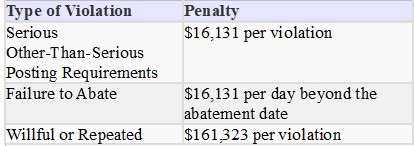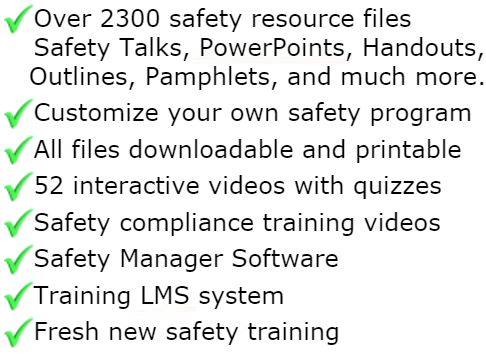
Hazardous Materials & Emergency Response
If you use or store hazardous materials you are required to have a response plan for spills and releases. Emergency response teams must be trained and equipped to respond to foreseeable emergencies
Incident Command System for Hazardous Materials Emergencies (ICS)
Be prepared. Know your subject by reading, talking to subject matter experts, or have documentation available so that you can answer questions intelligently.
A brief overview of the Incident Command System, or Hazardous Materials Emergency Response ICS, the responsibilities of the parties involved at an incident response and describe the system of command that is vital to a successful incident response.
The system consists of procedures for controlling personnel, facilities, equipment and communications. It's designed to begin developing from the time an incident occurs until the requirement for management and operations no longer exists.
The Hazardous Materials Emergency Response ICS has five major functional areas: Command, Operations, Planning, Logistics, and Finance. These components work together interactively to provide the basis for an effective Hazardous Materials Emergency Response ICS operation. To be effective, an incident management system must be suitable for use regardless of the type of jurisdiction or agency involvement.
Common elements in organization, terminology and procedures are necessary for maximum application of a system and use of existing qualifications and standards. Effective fulfillment of these requirements must be combined with simplicity to ensure low operational maintenance costs.
The Incident Commander, or IC, has many responsibilities that include placing life safety as the highest priority. The second priority is incident stabilization and the third priority is property conservation. The size and complexity of the command system developed and implemented by the IC should be directly proportional to the magnitude and complexity of the incident. The Incident Commander must also determine strategic goals and tactical objectives. Damage and injuries that have already occurred cannot be alleviated, but further damage and personal suffering must be minimized.
Coordination is essential to effective incident management. Without it, resources will be wasted performing tasks that aren't necessary to the overall success of the incident response. Proper coordination will ensure that units are functioning within the action plan.
A command post, of whatever size, provides a central, stationary location to assist the IC in incident command and control. The command post is a field office for management functions such as gathering, analyzing and disseminating information. The command post location should be announced as soon as possible so that persons with certain functional assignments know where to report.
Integrated communications involves managing communications through the use of a common communications plan. Standard operating procedures should be established using common terminology and clear text. Effective two way communication is essential to successful incident management. Not only is it important that messages are received, it's important that they are acknowledged properly.
The command function within Hazardous Materials Emergency Response ICS may be conducted in two general ways.
Single command may be applied when there is no overlap of jurisdictional boundaries or when a single IC is designated by the agency with overall management responsibility for the incident. Unified command may be applied when the incident is within one jurisdictional boundary, but more than one agency shares management responsibility. Unified command is also used when the incident is multi jurisdictional in nature, or when more than one individual designated by his or her jurisdiction or agency shares overall management responsibility.
Under the unified command concept, all involved agencies contribute to the command process. Overall goals, planning tactical objectives, conducting integrated tactical operations and maximizing the use of available resources are decided jointly.
Another important component of an effective emergency management system is a manageable span of control. Span of control is defined as the number of subordinates one supervisor can manage effectively. Guidelines for the desirable range are from 3 to 7 persons, while the optimum number is five subordinates per Supervisor. Command officers must anticipate span of control problems and prepare for them especially during rapid buildup of incident organization.
Like all other Hazardous Materials Emergency Response ICS functions, staging also has specific responsibilities. The Staging area manager should establish a check-in procedure, respond to requests for resources and keep the IC or Operations Section Chief informed of the status of resources in the staging area. A properly run staging area provides significant advantages. It allows for fire fighter safety and personnel accountability, prevents premature deployment of companies and prevents freelancing. All these advantages are made possible because companies are logged in and given assignments, maintaining control of resources.
The potential magnitude of the service and support requirements may indicate that the IC delegate the functional authority for logistics to the Logistics Section Chief who manages service and support resources required for the incident. This individual should establish functional units when needed to maintain an acceptable workload and span of control.
Financial considerations are not a major problem during most incident operations. However, when an organization is involved in any incident that requires the use of private sector resources or incidents where agencies involved in response will be seeking reimbursement, the financial considerations can be extensive.
All materials in the members area for this topic index
| Hazardous Materials Overview |
| Emergency Response Plan |
| Incident Command Checklist |
| Operations Checklist |
| Safety Control Checklist |
| Training Handout |
| Leak & Spill Response |
| Hazardous Material Team Training |
| General Hazardous Waste Operations |
| RCRA operations |
| HazMat Treatment, storage and disposal |
| Emergency Response Training |
| Definitions |
| Course Management |
| Hazardous Materials Course Criteria |
| Incident Command System Forms |
| Incident Briefing |
| Response Objectives |
| Organization Assignment List |
| Assignment List |
| Incident Radio Communications Plan |
| Medical Plan |
| Site Safety and Control Plan |
| Incident Status Summary |
| Status Change Card |
| Check-In List |
| General Message |
| Unit Log |
| Operational Planning Worksheet |
| Incident Plan Safety Analysis |
| Incident Plan Safety Analysis Instructions |
| Radio Frequency Assignment Worksheet |
| Support Vehicle Inventory |
| Resource Status Card (Crew) |
| Resource Status Card (Helicopter) |
| Resource Status Card (Aircraft) |
| Resource Status Card (Heavy Equipment) |
| Air Operations Summary Worksheet |
| Demobilization Checkout |

GET INSTANT ACCESS
to THE MEMBERS LIBRARY
Safety materials created by safety professionals.
Access to the Safety Manager software.
Wide variety of safety videos and courses.
**Brand New** Safety Training Management System
Pre-Made Safety Materials Ready For Use
Created by experienced safety professionals & risk consultants. Saving you time, money, and risk of injuries.
95% of the work already done.
Below are the maximum penalty amounts, with the annual adjustment for inflation, that may be assessed after Jan. 15, 2024. (See OSHA Memo, Jan. 8, 2024).

**New OSHA HEAT 90 DAY**
>>Download Free HERE<<
**New 2024 OSHA 300 Form**
>>Download Free HERE<<
**Brand New**
Free with full membership subscription
Training LMS System
Ask The Safety Consultant
Safety Equipment Deal Finder

“SafetyInfo.com is the first go-to website for safety professionals and companies to use in establishing a solid safety program"
-Mike McKenzie, Certified Safety & Health Manager (CSHM), McSafety Solutions™
Note: You must have a full subscription to the Safety Library in order to use this material. Any use outside of your organization, for resell, or without an active membership is strictly prohibited and may result in prosecution under copyright infringement laws. Please contact us first, if you would be interested in reselling or using our materials for reproduction.
Inside the Members Library
Topic Index
Accident Prevention
Air Quality
Asbestos
Bloodborne Pathogens
Boilers
Chemical Safety
Compressed Gas
Confined Space
Construction
Construction Worksite
Cranes & Slings
Driver / Fleet Safety
Drug Free Workplace
Electrical
Emergency Management
Engineering Safety
Environmental
Equipment
Ergonomics
Fall Protection
Fire Safety & Prevention
First Aid
Flammable Materials
Forklifts
Hazard Communication
Hazardous Materials
Hearing Protection
Heat Stress
Hot Work
Housekeeping
Job Safety Analysis
Laboratory
Ladders
Lead
Lockout-Tagout
Machinery & Equipment
Material Handling
MSDS (SDS)
Medical & First Aid
Occupational Health
Office Safety
Off the Job Safety
Personal Protection
Process Safety
Record Keeping
Respiratory Protection
Silica Safety
Rules & Policies
Signs & Labels
Slips, Trips & Fall
Training
Terrorism Programs
Tool Safety
Vehicle & Driver
Violence Programs
Welding & Hot Work
Training Videos
Library Index
Training Materials
Videos/Courses
Talks
Articles
PowerPoint
Handouts
Training Overheads
Quizzes
Supervisor Briefs
Management Briefs
Safety Sessions
2 Minute OSHA Safety Talks
Pamphlets
First Aid Training
Supervisor Training
Hazardous Materials
Bomb Threat
Crossword Puzzles
Biological Agents
Forms & Documents
Forms
Checklists
Audit Guides
Inspections Guides
Signs & Labels
Environmental Audit Guides
Recordkeeping - OSHA 300
Sign & Label Maker
Safety Management Resources
Safety Manuals/Written Programs
Ergonomic Programs
Emergency Plans
Process Safety Management
Construction Safety
Occupational Health
Environmental
Topic Sheets
DOT Fleet-Driver
Hazardous Materials
Chemical Safety
Drug Free Workplace
Terrorism Programs
Development Guides
Safety Manager Software
Safety References & Graphics
Technical Safety Information
Posters
Topic & Fact Sheets
Development Information
Job Specific Safety Rules
Terrorism
Calculators
Safety Comic Strips
New Safety Training System
Schedule and train your employees with our materials. Add unlimited amount of employees. Record all progress and issue certificates. For group and individual training sessions.

